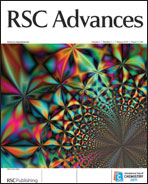Agarose hydrogel as an effective bioorganic ligand and support for the stabilization of palladium nanoparticles. Application as a recyclable catalyst for Suzuki–Miyaura reaction in aqueous media†
Abstract
In this article, the usefulness of an agarose hydrogel as an effective bioorganic


 Please wait while we load your content...
Please wait while we load your content...